
-
Find the right food for your pet
Take this quiz to see which food may be the best for your furry friend.
Find the right food for your pet
Take this quiz to see which food may be the best for your furry friend.
Featured products
 Adult 7+ No Corn, Wheat, Soy Chicken & Brown Rice Dog Food
Adult 7+ No Corn, Wheat, Soy Chicken & Brown Rice Dog FoodSupports energy level and beautiful coat in mature dogs
Shop Now Adult Perfect Weight & Joint Support Chicken Recipe Dry Dog Food
Adult Perfect Weight & Joint Support Chicken Recipe Dry Dog FoodThis weight management and mobility support dog food was created with Hill’s unique understanding of the biology of overweight dogs.
Shop Now Adult 7+ Perfect Digestion Chicken, Whole Oats & Brown Rice Recipe Dog Food
Adult 7+ Perfect Digestion Chicken, Whole Oats & Brown Rice Recipe Dog FoodScience Diet's breakthrough nutrition supports ultimate digestive well-being & healthy microbiome for dogs age 7+
Shop NowFeatured products
 Perfect Weight Salmon & Vegetable Canned Cat Food
Perfect Weight Salmon & Vegetable Canned Cat FoodOver 70% of cats lost weight within 10 weeks when fed this nutrition
Shop Now Adult Savory Chicken Entrée Cat Food
Adult Savory Chicken Entrée Cat FoodPrecisely balanced nutrition with the delicious taste of savory minced chicken to help fuel the energy needs of cats during the prime of their life
Shop Now Adult Perfect Digestion Chicken, Barley & Whole Oats Recipe Cat Food
Adult Perfect Digestion Chicken, Barley & Whole Oats Recipe Cat FoodScience Diet's breakthrough nutrition supports ultimate digestive well-being & healthy microbiome
Shop Now -
Dog
- Dog Tips & Articles
-
Health Category
- Weight
- Food & Environmental Sensitivities
- Urinary
- Digestive
- Joint
- Kidney
-
Life Stage
- Puppy Nutrition
- Adult Nutrition
- Senior Nutrition
Cat
- Cat Tips & Articles
-
Health Category
- Weight
- Skin & Food Sensitivities
- Urinary
- Digestive
- Kidney
-
Life Stage
- Kitten Nutrition
- Adult Nutrition
Featured articles
 The Incredible Science Behind Your Pet's Microbiome
The Incredible Science Behind Your Pet's MicrobiomeLearn what a pet's microbiome is, how it contributes to your pet's gut & overall health, and why nutrition is important in maintaining healthy microbiomes.
Read More Pet Food Storage Tips
Pet Food Storage TipsDiscover how and where to store your dry, as well as canned, dog and cat food. Learn how to find the "best before" dates on all Hill's pet food packaging.
Read More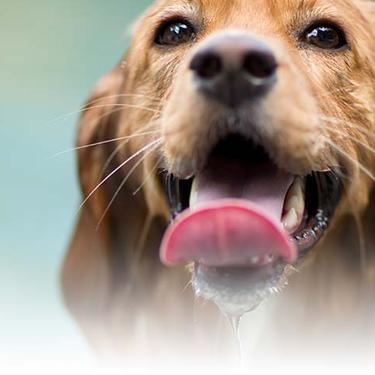 Water
WaterDiscover why water is the most important nutrient for your dog or cat to live a healthy life. Find out how much water your pet should consume each day.
Read More -
Find the right food for your pet
Find the right food for your pet


If you have a dog who loves exploring, then you might be familiar with this scenario: you're relaxing in your backyard with your pup when all of a sudden, they notice a skunk nearby and decide to investigate. It doesn't matter how loudly you call for your pet or how quickly you run toward them, the skunk still gets spooked.
You've heard stories about how difficult getting rid of skunk smell in dog fur can be, so what can you do about a dog sprayed by a skunk? Should you bring your dog to the vet, or are there actions you can take at home?
Let's explore what to do immediately after your dog gets sprayed by a skunk, and steps for removing the skunk smell.
Why Do Skunks Spray?
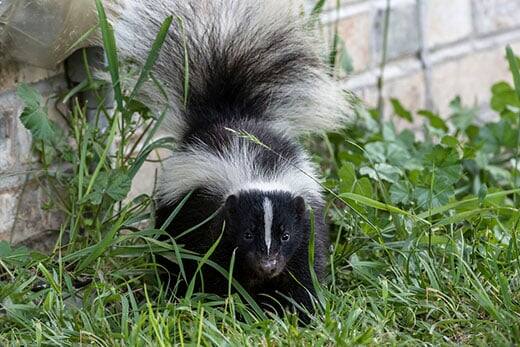
Was your dog sprayed by a skunk? Yikes! It can be a scary circumstance to find yourself in, and you might be wondering why skunks spray in the first place. Quite simply, skunks spray as a defense mechanism. As noted by Smithsonian Magazine, if approached, skunks will often try to stamp their feet to ward off unwanted attention. If that's not successful, they'll raise their tail, aim and spray at whomever is approaching. While their spray is very unpleasant, it mostly won't affect your pet (except their sense of smell).
According to Smithsonian Magazine, "Skunk spray is a thiol, an organic compound with sulfur as a principal component." Their spray is so powerful that it can hit 10 feet away with accuracy and be smelled even a mile away. The article continues, "Generally, the spray doesn't cause much harm — maybe stinging in the eyes or temporary blindness, and nausea in humans."
When your dog spooked the skunk, it most likely sprayed to ward them off. And it worked! Your pet backed off, buying the skunk some time to run away.
My Dog Got Sprayed: Assessing the Situation & Getting Rid of Skunk Smell
Now that you understand why skunks spray, here are a few steps to rid the smell from your dog.
1. Identify If There's Any Immediate Danger
The first thing you should do if you find your dog gets into an altercation where they wind up sprayed by a skunk is to check to see the extent of the situation. Did the skunk's spray actually hit your dog? If so, make sure to check your pet's eyes for any signs of redness or irritation. Also, check your dog carefully for any evidence of wounds as skunks are common carriers of the rabies virus, which can be transmitted through the bite of an infected animal. Because skunks are typically active at night, a daytime encounter should raise additional red flags about the possibility that your pup was exposed to a rabid, or otherwise unhealthy, skunk. If you don't see any evidence of injury, you may not need to worry about taking them to the vet. However, a call to your vet is recommended to verify whether or not they want to evaluate your dog.
However, if your dog's eyes did get sprayed call your vet and ask how they recommend handling the situation. They may want to fully assess your pet, or they may recommend rinsing your dog's eyes for a short period of time with cool water and monitoring them to make sure they don't develop any other signs while recovering. It's also important to discuss with your vet their level of concern about the possibility of rabies exposure, regardless of your dog's vaccination status, and whether any monitoring for signs of illness should be performed. Rabies has the ability to be transmitted between animals and people, so it's important that you work with your veterinarian to follow whatever measures they recommend to keep your pup, and your family, safe.
2. Try to Keep Your Pet Outdoors
If you're used to washing your dog inside of your home, you might be tempted to bring your pup indoors to clean them off. However, you don't want to get any of the spray or smell into your home. If you do, not only will you need to clean your dog, but you'll need to clean anything they come in contact with inside your home, as well.
It's difficult to remove the smell from your home, but if you aren't able to avoid your pet going inside, it helps to run fans throughout your home and open boxes of baking soda to help absorb the smell. Ultimately, there's no immediate relief from indoor skunk smell, so you might have to wait some time.
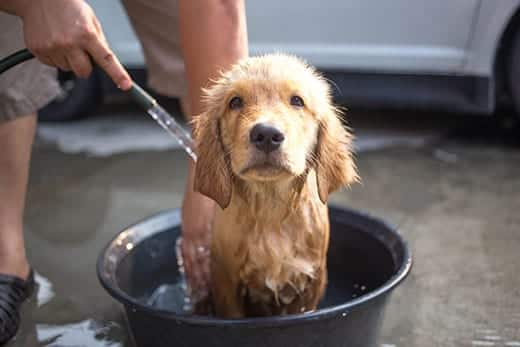


Tasty Tips
3. Make and Apply a DIY Solution
Mass Audubon shares that pet parents should first wipe their dog's coat off with a paper towel. Then, they suggest creating a solution with ingredients you likely have at home right now, and no — tomato sauce doesn't make the list. Instead, they call for the following: 1 quart of hydrogen peroxide (3%), 1/4 cup of baking soda and 1 teaspoon of dish detergent. They advise pet parents to avoid the eyes, ears and mouth, but to make sure it's applied to the fur completely. Pro tip: use an old washcloth so you can throw it away when you're done. Because hydrogen peroxide can lighten your dog's fur, it's important to make sure it gets evenly distributed and massaged in, but also that it doesn't stay on for too long.
Once you're confident that your pet is covered in solution, rinse them thoroughly. For small sprays, one application might do the trick to remove the smell. However, if it doesn't go away, reapply and rinse a few times. Then, follow up with one good wash using their usual dog shampoo.
If you're unable to find those three above-mentioned ingredients, the American Kennel Club (AKC) says, "The next best option is one of the old-time remedies: vinegar diluted with water. While not as effective, it may still help clean your dog and get rid of the smell." You can also consult your veterinarian for some more professional products that can do the trick.
4. Clean Yourself and Any Belongings
You'll also want to apply the aforementioned solution to yourself as well, if any of the skunk spray got onto your body during the ordeal or later as you attempted to corral and clean your pet. The AKC suggests using regular laundry detergent with a 1/2 cup of baking soda added to help remove the smell from your clothes.
If the skunk happened to spray any outdoor furniture or belongings, Mass Audubon recommends washing with a solution of one part bleach and nine parts water, so long as it isn't used on fabric.
Was your dog sprayed by a skunk? Take a moment and analyze the situation before panicking. Your pet is likely going to be just fine, and you have options for helping them get cleaned up. It might seem like the smell will last forever, but with a few good washes, the memory of the skunk spray — and that unmistakable scent — will fade.


Erin Ollila believes in the power of words and how a message can inform—and even transform—its intended audience. Her writing can be found all over the internet and in print, and includes interviews, ghostwriting, blog posts, and creative nonfiction. Erin is a geek for SEO and all things social media. She graduated from Fairfield University with an M.F.A. in Creative Writing. Reach out to her on Twitter @ReinventingErin or learn more about her at http://erinollila.com.
Related products

Supports energy level and beautiful coat in mature dogs

Delicious braised beef paired with tender vegetables in a succulent stew

This weight management and mobility support dog food was created with Hill’s unique understanding of the biology of overweight dogs.

Science Diet's breakthrough nutrition supports ultimate digestive well-being & healthy microbiome for dogs age 7+
Related articles

Large and giant breed puppies have different nutritional needs than other dogs. Learn how to provide the special care they need to grow up big and strong.
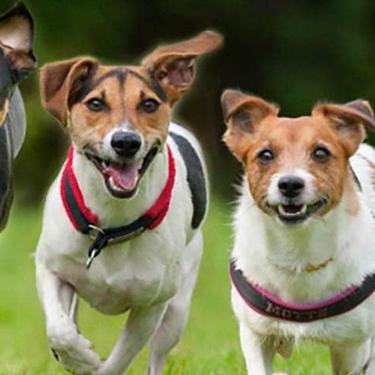
Learn about Hill's puppy food and the nutritional benefit & high quality ingredients that it contains for your pup.
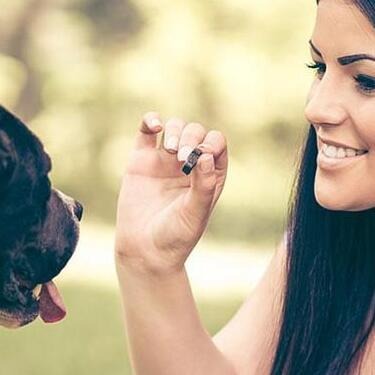
Proper nutrition for your pregnant or nursing dog is vital to her and her puppy's health. Learn what you should do provide her with the proper nutrients.

Understand the role that Omega-6 and Omega-3 fatty acids play in your dog's overall health, and how you can ensure they are getting enough.

Put your dog on a diet without them knowing
Our low calorie formula helps you control your dog's weight. It's packed with high-quality protein for building lean muscles, and made with purposeful ingredients for a flavorful, nutritious meal. Clinically proven antioxidants, Vitamin C+E, help promote a healthy immune system.
Put your dog on a diet without them knowing
Our low calorie formula helps you control your dog's weight. It's packed with high-quality protein for building lean muscles, and made with purposeful ingredients for a flavorful, nutritious meal. Clinically proven antioxidants, Vitamin C+E, help promote a healthy immune system.

